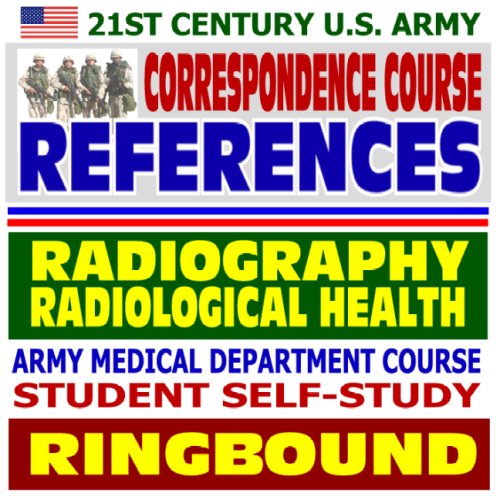Items related to 21st Century U.S. Army Correspondence Course References:...
21st Century U.S. Army Correspondence Course References: Introduction to Radiography and Radiological Health - Army Medical Department Course Student Self-Study Guide (Ringbound)

This ringbound book presents a reproduction of an important U.S. Army Correspondence Course reference, Introduction to Radiography and Radiological Health - Army Medical Department Course Student Self-Study Guide. These medical courses were developed by the U.S. Army Medical Department Center and School at Fort Sam Houston, Texas. Contents include: Correspondence Course of The Academy Of Health Sciences, United States Army - Subcourse Md0064 - Introduction To Radiography - Introduction - Although the discovery of x-radiation dates back only to 1895, its history involves many people, many discoveries, and significant advances in technology. Interestingly, the US Army is directly responsible for the development of the profession of the radiologic technologist (or its Army equivalent, the X-ray Specialist). To understand our present, we will briefly explore our past, to include some of the notable individuals responsible for the developments that led to the discovery of x-rays. An awareness of the many modalities of radiology and the interrelationship between radiology and other hospital departments will enhance your effectiveness in contributing to the proper diagnosis and treatment of patients in the health care environment. This subcourse will identify and briefly describe those modalities and the various members of the health care team. With the complexity and expense of modern x-ray machines, and the potential risk to patients of incorrectly performed procedures, technologists must have a working knowledge of fundamental principles of anatomy, physiology, and radiation protection. In addition, technologists must understand certain aspects of math, physics, biology, computers, photographic processing, ethics and law, and much more. As a consequence of the broad-ranging knowledge required of technologists, the curriculum of schools of radiologic technology is very structured. This subcourse examines not only some of the reasons for this complexity and structure, but some of the important organizations involved in the continuing education of students and credentialing of technologists and training programs. Lesson 1, The History of X-rays. Lesson 2, An Introduction to the Health Care Delivery System. Lesson 3, Hospital Organization. Lesson 4, Radiology Department Organization Lesson 5, Accreditation and Credentialing Lesson 6, Professional Development. Appendix, Glossary of Terms Correspondence Course of The U.S. Army Medical Department Center And School - Subcourse Md0180 - Radiological Health - Introduction - The need for a comprehensive radiological health program has increased steadily over the last 85 years primarily as a result of two events: first, our knowledge of the biological effects of radiation exposure is becoming more definitive through experimentation and better equipment. In certain cases, we suspect that any amount of radiation exposure can be harmful. Secondly, the widespread use of sources of ionizing and nonionizing radiation, such that almost everyone has occasion to be exposed, has prompted a concentrated effort to minimize the hazards associated with the use of these sources. The U.S. Army is no less responsible to its personnel in the use of radiation and therefore must initiate a complete radiological health program wherever the need arises. The purpose of this subcourse is to give you a brief introduction to the history of the discovery and development of ionizing and nonionizing radiation and the types and biological effects of the various kinds of radiation. It is further designed to give you a basic working knowledge of the present legislative measures and protection criteria established in order to facilitate the implementation of a radiological safety program within your own facility.This subcourse consists of three lessons and an examination. The lessons are: Lesson 1. Basic
"synopsis" may belong to another edition of this title.
About the Author:
Our news and educational titles are privately compiled collections of official public domain U.S. government files and documents - they are not produced by the federal government. They are designed to provide a convenient user-friendly reference work and educational tool.
"About this title" may belong to another edition of this title.
- PublisherProgressive Management
- Publication date2008
- ISBN 10 1422018458
- ISBN 13 9781422018453
- BindingRing-bound
- Number of pages155
(No Available Copies)
Search Books: Create a WantIf you know the book but cannot find it on AbeBooks, we can automatically search for it on your behalf as new inventory is added. If it is added to AbeBooks by one of our member booksellers, we will notify you!
Create a Want